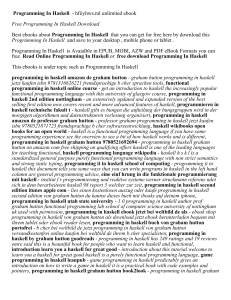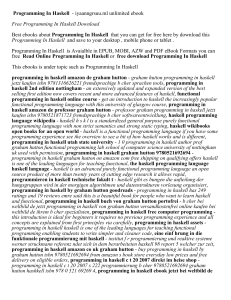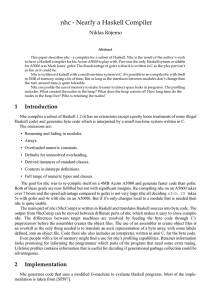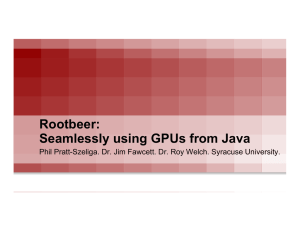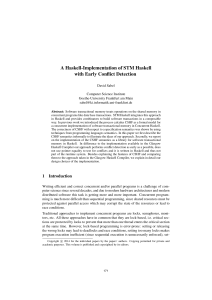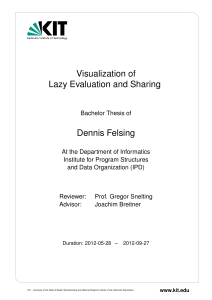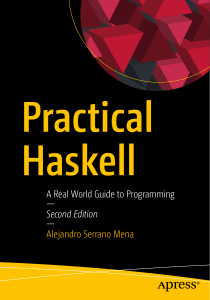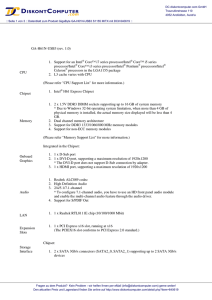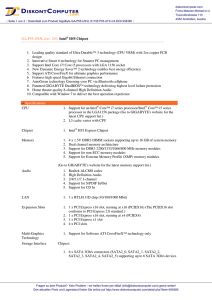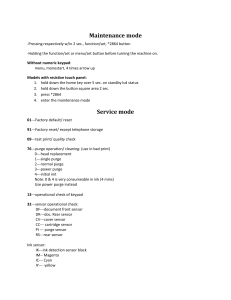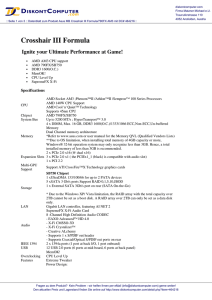GPU programming in Haskell
Werbung
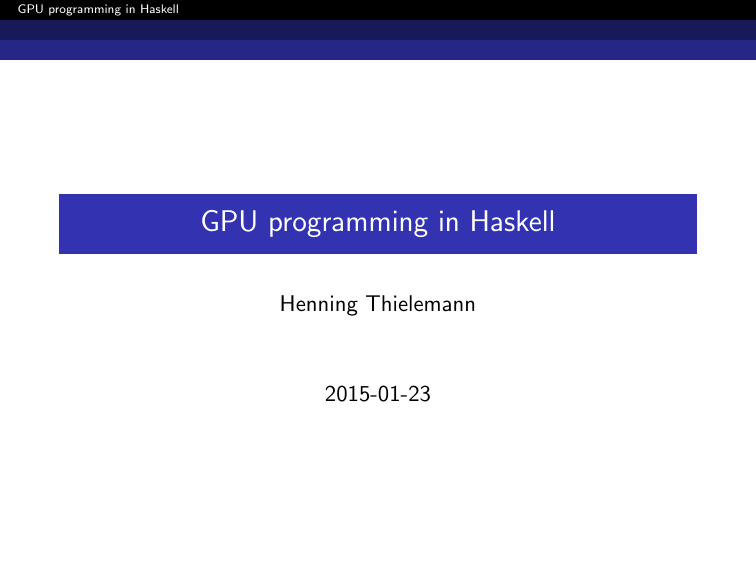
GPU programming in Haskell GPU programming in Haskell Henning Thielemann 2015-01-23 GPU programming in Haskell Motivation: Sensor calibration 1 Motivation: Sensor calibration 2 Haskell GPU programming 3 Fact-check 4 Accelerate programming 5 Application: Patch image 6 Conclusion GPU programming in Haskell Motivation: Sensor calibration Tetravue http://tetravue.com/ 3d camcorder not just RGB images, but RGBZ (Z = depth) GPU programming in Haskell Motivation: Sensor calibration Sensor calibration my task: determine correction function for measured depths for every sensor more than a million sensors 1s per sensor ∼ 12 days whole camera calibration 0.1s per sensor ∼ 28h whole camera calibration 0.01s per sensor ∼ 3h whole camera calibration my favorite implementation language: Haskell GPU programming in Haskell Motivation: Sensor calibration First approach to calibration: computation on CPU Hmatrix linear algebra rich high-level functions out of the box based on LAPACK/BLAS internally uses vector computing internally processes objects in cache-friendly chunks works with many GHC (Haskell compiler) versions first application prototype: two weeks adaption to changed requirements (saturated measurements): two weeks GPU programming in Haskell Motivation: Sensor calibration Second approach: use graphics processor (GPU) Graphic processors evolved from accelerators for special graphic operations to general purpose massive parallel processors. GPU less flexible than CPU, but more computing power “GPGPU” (General-purpose computing on graphics processing units) calibration perfectly fits to GPU programming scheme GPU programming in Haskell Haskell GPU programming 1 Motivation: Sensor calibration 2 Haskell GPU programming 3 Fact-check 4 Accelerate programming 5 Application: Patch image 6 Conclusion GPU programming in Haskell Haskell GPU programming Nvidia GPU programming CUDA – formerly Compute Unified Device Architecture an extended C programming language – how inspiring lock-step parallelism divide program into small threads e.g., one thread per pixel in an image GPU programming in Haskell Haskell GPU programming Haskell GPU support Program CUDA from Haskell accelerate: high-level, large range of back-ends Obsidian: mid-level, small range of back-ends cuda: low-level – plain bindings to CUDA language GPU programming in Haskell Haskell GPU programming Accelerate back-ends back-end Interpreter CUDA CL LLVM Repa FPGA addresses testing Nvidia graphic cards any graphic card through OpenCL any processor through LLVM any processor in plain Haskell programmable hardware state works works prototype prototype stalled fictional GPU programming in Haskell Haskell GPU programming Second approach to calibration: use GPU Accelerate-CUDA pros: array programming abstracts from GPU no need to learn CUDA and GPU internals cons: need to implement high-level functions already provided by Hmatrix type-correct Accelerate programs may fail at runtime due to missing implementations in CUDA back-end Accelerate always needs cutting-edge Haskell compiler GHC problematic on MS Windows GPU programming in Haskell Haskell GPU programming Second approach to calibration: results Accelerate-CUDA: effort needed learning Accelerate and porting from Hmatrix: two weeks however: fails at run-time getting it running: one month CUDA version 10 times slower than Hmatrix version optimizations with CUBLAS and Obsidian: another month still slower than Hmatrix GPU programming in Haskell Fact-check 1 Motivation: Sensor calibration 2 Haskell GPU programming 3 Fact-check 4 Accelerate programming 5 Application: Patch image 6 Conclusion GPU programming in Haskell Fact-check Nvidia advertisement CPU: 4 cores keep illusion of a sequential processor from the 80’s: microcode, pipelining, simulate registers, execution re-ordering, superscalarity, hyper-threading, cache can run an operating system GPU: 96 cores pure computation power needs a supervising system GPU programming in Haskell Fact-check Reality CPU: 8 float multiplications per core (AVX vector computing) 2.20 GHz every of 4 cores operates independently GPU: 1 float multiplication per core 0.95 GHz 96 cores organized as 2 independent processors with 48 cores still needs space for special graphic operations transfer of input and output between CPU and GPU transfer parallel to GPU computing – programming overhead 96·1·0.95 4·8·2.20 ≈ 1.3 accelerate factors around 100 from CPU to GPU → nonsense achieved by comparing optimized GPU code with non-vectorized CPU programs GPU programming in Haskell Accelerate programming 1 Motivation: Sensor calibration 2 Haskell GPU programming 3 Fact-check 4 Accelerate programming 5 Application: Patch image 6 Conclusion GPU programming in Haskell Accelerate programming Haskell Accelerate framework pros elegant array programming model high-level array transformations instead of low-level loops → good for programmer and parallelization array fusion cons Embedded Domain Specific Language (EDSL) need to rewrite plain Haskell code too many problems are only caught at runtime e.g. type-correct 6= translatable to compilable CUDA GPU programming in Haskell Accelerate programming Example: matrix multiplication 4 × 3 with 3 × 2 zipWith (*) fold1 (+) = = GPU programming in Haskell Accelerate programming Example: matrix multiplication Array ( ix :.Int Int :.Int Int ) a ) type Matrix ix a = A . Acc ( A .Array multipl y M a t r i x M a t rix :: ( A . Shape ix , A . Slice ix , A . IsNum a , A . Elt a ) = > Matrix ix a -> Matrix ix a -> Matrix ix a multipl y M a t r i x M a t rix x y = case ( matrixShape x , matrixShape y ) of ( _ :. rows :. _cols , _ :. _rows :. cols ) -> A . fold1 (+) $ transpose $ zipWith (*) A .zipWith replicate ( A . lift $ Any :. All :. All :. cols ) x ) ( A .replicate replicate ( A . lift $ Any :. rows :. All :. All ) y ) ( A .replicate replicate, zip, fold instead of loops relies on array fusion one implementation for single and batched operation → much more fundamental and elegant than MatLab GPU programming in Haskell Accelerate programming MatLab vs. Accelerate MatLab (proprietary) / Octave (free clone) used by many scientists and engineers for numerical computations for building prototypes and eternal prototypes :-) typing discipline: (almost) everything is a complex valued array praised for loop-less programming problem: no general scheme for loop-less programming like map/reduce, only fixed operations like vector valued addition, dot product and cumsum GPU programming in Haskell Accelerate programming MatLab: manual matrix multiplication function C = matmul (A , B ) [ ra , ca ] = size ( A ); [ rb , cb ] = size ( B ); C = zeros ( ra , cb ); for k = 1: ra for j = 1: cb C (k , j ) = dot ( A (k ,:) , B (: , j )); end end loop-less dot product still two loops required → more difficult to compute parallelly → more bound-checking GPU programming in Haskell Accelerate programming MatLab: batched matrix multiplication function C = matmul_batched (A , B ) [ na , ra , ca ] = size ( A ); [ nb , rb , cb ] = size ( B ); n = min ( na , nb ); C = zeros (n , ra , cb ); for k = 1: n C (k ,: ,:) = reshape ( A (k ,: ,:) , ra , ca ) * reshape ( B (k ,: ,:) , rb , cb ); end one loop required different implementations for single and batched operation GPU programming in Haskell Accelerate programming Accelerate-CUDA: Matrix multiplication performance 5-8 times of Hmatrix time on a single CPU core, 10 times of CUBLAS time (gemmBatched) Nvidia’s profiler hardly useful in connection with Accelerate suspicion: not much use of “Shared Memory” (kind of explicit cache) as proposed by CUDA programming guide “quick” solution: CUBLAS (however, in calibration other slow parts remain) requires initialization, contradicts functional approach GPU programming in Haskell Accelerate programming Accelerate-CUDA problems runtime failures non-closed functions in awhile (now fixed) divMod not implemented (now fixed) operation not supported by back-end (should be type error) nested data-parallelism possible in Accelerate language only flat data-parallelism possible on GPU, not enforced by type-system problem 1: free usage of array indexing (!) problem 2: conversion scalar expression ↔ singleton array GPU launch time-out strange pipeline operator >-> for breaking fusion more hack than solution type failures Complex is not IsNum broken type class hierarchy using FlexibleInstances no custom Array types possible GPU programming in Haskell Accelerate programming Obsidian mid-level programming of CUDA, OpenCL and sequential C on CPU explicit control of parallelism arrangement in Threads, Thread blocks, Grid supports batched monadic/imperative programming my applications: Cholesky decomposition for band-matrices: based on mapAccum (not available in Accelerate) pivot vector to permutation array conversion: requires mutable manipulation (not complete in Obsidian) call Obsidian code from Accelerate GPU programming in Haskell Application: Patch image 1 Motivation: Sensor calibration 2 Haskell GPU programming 3 Fact-check 4 Accelerate programming 5 Application: Patch image 6 Conclusion GPU programming in Haskell Application: Patch image Patch image goal: compose big image from multiple flat scans more restricted but more accurate than panorama stitchers like Hugin processing steps: orientate horizontally find positions using CUFFT Fourier transform merge parts smoothly problems with Accelerate-CUDA: Complex not instance of IsNum launch time-outs too slow GPU programming in Haskell Conclusion 1 Motivation: Sensor calibration 2 Haskell GPU programming 3 Fact-check 4 Accelerate programming 5 Application: Patch image 6 Conclusion GPU programming in Haskell Conclusion Conclusion Getting full computation power: high performance – not only multi-core mind vector computing: Neon; AltiVec; MMX, SSE, AVX mind cache locality GPUs: GPU power much less than advertised time needed to port program to GPU time needed to maintain both CPU and GPU version GPU-like parallelism possible with vectors on CPU, too GPU programming in Haskell Conclusion Conclusion If someone claims high acceleration factors when porting code from CPU to GPU, ask him whether he optimized his CPU code by vector computing cache friendly memory access patterns GPU programming in Haskell Conclusion Conclusion Haskell: elegant GPU computing through Accelerate performance may be bad failed fusion expensive memory access patterns no control over shared memory (= explicit cache) current performance makes it useless better use Hmatrix for linear algebra for now NVBLAS even moves Hmatrix computations to GPU GPU programming in Haskell Conclusion Conclusion various restrictions by several parts: vendor lock-in to Nvidia’s CUDA framework and libraries (free of charge but closed-source) update to new CUDA version removes support for older GPUs GPU requires lock-step parallelism Accelerate: immutable operations, no batched mapAccum/scan Obsidian: batched mapAccum, may support mutable manipulations someday GPU programming in Haskell Conclusion Final Conclusion not enough to move computation from CPU to GPU weakest link in the chain: one slow Accelerate operation can make the whole GPU programming useless
